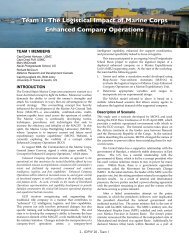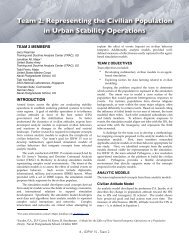pdf file - SEED Center for Data Farming - Naval Postgraduate School
pdf file - SEED Center for Data Farming - Naval Postgraduate School
pdf file - SEED Center for Data Farming - Naval Postgraduate School
Create successful ePaper yourself
Turn your PDF publications into a flip-book with our unique Google optimized e-Paper software.
Results<br />
For each Y-variable, we used JMP statistical software to fit<br />
a regression model to a set of 75 potential predictors, i.e. the<br />
variables shown in Table 1, their squares, and all first-order<br />
(pairwise) interaction terms. JMP per<strong>for</strong>med stepwise<br />
regression, allowing variables to enter and leave the model<br />
based on their significance (p-value).<br />
Table 2 shows the X-variables that were included in the<br />
model, as well as the R2 and adjusted R2 <strong>for</strong> each model.<br />
Wave threshold and wind threshold proved to be the most<br />
significant in the current Matlab implementation of the<br />
PPSNext model, and at least one of these two variables<br />
appeared in the model <strong>for</strong> every Y-variable.<br />
The absence of some X-variables is very interesting. For<br />
example, these results seem to indicate that it is not important<br />
<strong>for</strong> intelligence to learn whether pirates can acquire and use<br />
METOC <strong>for</strong>ecasts, nor would it change the PPSNext if they<br />
acquired that capability.<br />
The !-prefixed Y-variables measure differences within a<br />
single simulation (design point) over the 72-hour simulated<br />
time period, rather than differences relative to the other<br />
design points. There<strong>for</strong>e, the X-variables that are most related<br />
to the ! Y-variables can be interpreted as those that have the<br />
largest interaction with METOC conditions. Both wind and<br />
wave thresholds appear in the model <strong>for</strong> every ! Y-variable,<br />
indicating that (not unexpectedly) wind and wave thresholds<br />
interact strongly with METOC conditions in determining the<br />
spatial distribution of pirate activity. The wind drift factor<br />
and mission length do not appear in any of these models,<br />
however, indicating that they do not interact strongly with<br />
METOC conditions.<br />
X-variables that might be estimated using intelligence<br />
also appear to drive the results, in particular mission length.<br />
The interaction between mission length and wind threshold<br />
in two of the models is interesting. The number of sea bases<br />
or camps – which are highly related, as the number of sea<br />
bases is a fraction of the total number of bases – appear in<br />
many of the models, indicating that it would be valuable to<br />
have good estimates of the number of bases.<br />
The results do not provide clear guidance as to which of<br />
the output measures are more useful. In addition, smoothing<br />
does not have a consistent effect on the significance of the<br />
results. For some measures, the smoothed output model<br />
achieves greater R2 than the raw value and <strong>for</strong> some measures<br />
the opposite. The smoothed MaxDiff did not produce any X-<br />
variables that were significant at least at the 0.01 level, and<br />
there<strong>for</strong>e its model is not shown in Table 2.<br />
Future Work<br />
Near-term future work on this project (in the next year)<br />
includes running similar experiments using the operational<br />
code, which will include environmental and navigational<br />
conditions <strong>for</strong> specific, real area of operations, in particular the<br />
area off the HOA plus the Gulf of Aden. We will seek to<br />
confirm the qualitative results of the experiments conducted<br />
during IDFW-20, to identify which aspects of pirate CONOPS<br />
are most critical in interaction with METOC conditions and<br />
METOC uncertainty.<br />
Another major component of future work in the next year<br />
is the possibility of building an agent-based model that will be<br />
able to represent other factors that we know to be important<br />
to the problem of detecting and protecting against the pirate<br />
threat. In particular, we would like to add agents that<br />
represent commercial shipping, the searchers and neutral<br />
vessels. We spent some of our time researching environments<br />
<strong>for</strong> implementing an agent-based piracy model and the key<br />
features that we would like to see included.<br />
Donna Middleton (Northrop Grumman) gave us a<br />
demonstration of Pythagoras, including a simulation she<br />
created to capture the effects of currents and waves.<br />
Pythagoras has the flexibility to model pirate behaviors such<br />
as seasickness and incorporate behavioral habits where<br />
pirates run out of cot, food, or water so they return to their<br />
origin at different times <strong>for</strong> a single time step simulation.<br />
Another great asset <strong>for</strong> agent based modeling is the ability to<br />
run a multitude of simulations quickly. The downfall of using<br />
this agent-based model is the inability to model METOC as<br />
fluid dynamics since weather conditions change with each<br />
time step. METOC would be static while the agents would be<br />
dynamic. Although this feature is not represented in the<br />
current pirate simulation, it would be nice to allow agents to<br />
have imperfect in<strong>for</strong>mation about METOC conditions,<br />
representing a <strong>for</strong>ecast.<br />
Mary McDonald also visited our team to discuss the<br />
applicability of MANA to this problem. We took some time to<br />
analyze the pros and cons between each agent-based model.<br />
MANA did not have the model flexibility that we so desired<br />
with modeling pirate agents and it too has the inability to<br />
model changing METOC conditions. Abel (2009) used<br />
MANA productively to model frigate defense effectiveness<br />
against pirate activity because MANA enabled him to model<br />
quadrant dimensionality of the frigate in the <strong>for</strong>m of port,<br />
starboard, <strong>for</strong>e, and aft.<br />
References<br />
[1] Abel, H. Frigate Defense Effectiveness in Asymmetrical<br />
Green Water Engagements . Master’s thesis, <strong>Naval</strong><br />
<strong>Postgraduate</strong> <strong>School</strong>, Monterey, CA><br />
[2] Cioppa, T.M. & Lucas, T.W. (2007) Efficient Nearly<br />
Orthogonal and Space-Filling Latin Hypercubes.<br />
Technometrics 49(1):45-55.<br />
[3] Murphy, M.N. (2009) Small Boats Weak States Dirty<br />
Money: Piracy and Maritime Terrorism in the Modern<br />
World. Columbia University Press, New York. 539 pp.<br />
53 - IDFW 20 - Team 14




